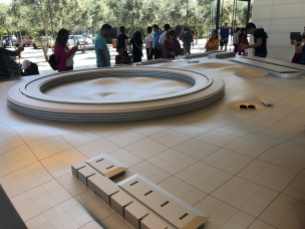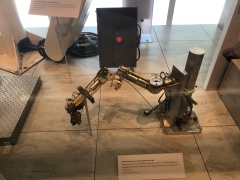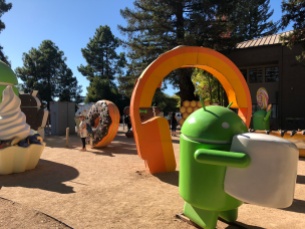I recently did a self-tour of Silicon Valley, and as someone who works in the field of technology, it was a fantastic experience.
The first stop of the tour was Apple Park, the Head Quarters for Apple Inc. The only section open to the public is the Visitor Center, which mainly consists of a massive apple store (which was insanely busy as it was 2 days after the iPhone 11 and 11 Pro launched) as well as a sizeable Augmented Reality display of the Apple Park Campus and the famous UFO looking Apple Ring building. This AR display consists of a large model, shown in the photos below, that you can interact with using an iPad Pro which the staff hand out to guests entering the display area. On the iPad Pro graphics are superimposed over the model showing not only a realistic aerial view of the campus but also showing various bits of information relating to the design of the ring building such as how the ring building is designed in a way to take advantage of the environment (wind, etc.) to cool itself in an ecologically friendly manner.
The next stop was the Apple Garage, which is the garage at the house in which Steve Jobs grew up. It is commonly considered the birthplace of Apple. Steve Wozniak (Apple co-founder) has said that this is a bit of a romanticized myth, but it was still great to see.

Next came the Computer History Museum, a truly amazing museum with items covering the entire history of computers. From the abacus to mainframes and supercomputers to the current day smartphone, the items on display are truly astonishing. Below are some photos and descriptions of some of the items on display.
Numerous Abacuses on display, one of the oldest forms of calculation tools.
A variety of mechanical calculation machines.

A Curta Calculator, also known as the Pepper Grinder Calculator. One of the most advanced handheld mechanical calculators ever created.
A Selection of IBM Mainframe Equipment.

A model of ENIAC, the world’s first general-purpose computer.

A Selection of Fortran Programming Books and Promotional Material.
A PDP-1 Display, Spacewar! one of the first video games ever was programmed on and ran on the PDP-1.

A 486 DX motherboard.
A display showing the advancement of transistors, microprocessors, silicon wafers, and Moore’s Law.
Various Robots on display. Including expensive toys, industrial robots, and research robots.
Numerous bizarre and unusual computer peripherals on display.
Video and computer gaming displays, with various consoles and games on display.
Apple I, Apple II, Apple Lisa, and Original Macintosh computers.
IBM PC Model 5150 and an Altair 8800.

A boxed copy of Windows 1.0.

The NeXTcube workstation from NeXt Computers. NeXt computers were founded by Steve Jobs after leaving Apple in 1985, and Next Computers were acquired by Apple when Steve Jobs rejoined Apple in 1997. The NeXTStep Operating system became the foundation for Mac OSX.

Waymo Self-Driving Car.

A scale model of the Mars Rover.
World of Warcraft exhibition.
An exhibition showing the rise of MP3s and the rise and fall of Napster.
The next stop after the Computer History Museum was the Googleplex, the massive headquarters of Google. The Googleplex, which is mostly open to the public, has various significant things to see, such as the Android Statue Lawn, where retired Android statues representing previous versions of the mobile operating system are on display. From volleyball courts to Massive Statues to vegetable gardens, it is easy to see why the Google Campus has a reputation as the best working environment. Here are a few photos of the Googleplex.
The last stop in Silicon Valley was Stanford University, a University that amongst its alumni has various famous people. Stanford has a beautiful Campus, as can be seen in the photos below.




























































































